Bedbugs
Bedbugs have feasted on sleeping humans for thousands of years. After World War II, they were eradicated from most developed nations with the use of DDT. This pesticide has since been banned because it's so toxic to the environment.But if you're thinking of going to Shaolin, or anywhere in China in general, you're more than likely going to become intimate with these little critters. Here's some information that you might find helpful.
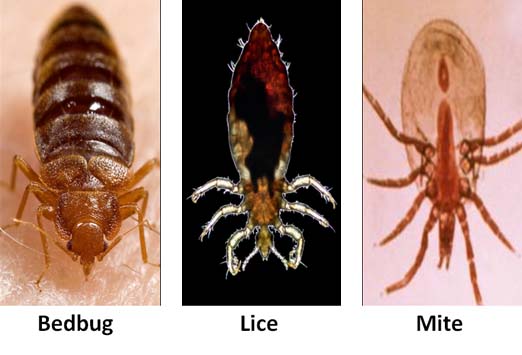
Spurred perhaps by increases in international travel, bedbugs are becoming a problem once again. Bed bugs are common in eastern European and third world countries, especially in areas of extreme poverty. The blood-sucking parasites had nearly disappeared in developed countries until recently; in the last 5 to 10 years, they have been making a rapid comeback. The parasites have recently been reported as increasingly common inside US hotel rooms.The risk of encountering bedbugs increases if you spend time in places with high turnovers of night-time guests — such as hotels, hospitals or homeless shelters. Human infestation with bedbugs, lice, and mites are common causes of dermatologic symptoms. Although these organisms thrive in conditions of overcrowding and decreased sanitation, Americans of all socioeconomic backgrounds may be at risk for infestation. Clinicians must maintain high suspicion in the appropriate set of clinical circumstances to identify and treat infestations, as they can cause substantial dermatologic and psychological discomfort for patients.
 Bedbugs are parasitic arthropods from the family Cimicidae. The common bed bug, Cimex lectularius, has been an associate of humans for thousands of years. The word Cimex is derived from the Roman designation for bug, and lectularius from the Latin name for couch or bed. Bedbugs are reddish brown, oval and flat, about the size of an apple seed. During the day, they hide in the cracks and crevices of beds, box springs, headboards and bed frames. Bed bugs are cosmopolitan in distribution, found in temperate re gions worldwide. Another bed bug species, Cimex hemipterus, is also wide spread but is found mostly in the tropics. Several other bed bug species are found on bats, but they do not bite people. Adult bed bugs are approximately 5 mm long, oval, and flattened. They somewhat resemble unfed ticks or small cockroaches. Adults are reddish brown (chestnut), immature bugs resemble adults but may be yellowish white. Bed bugs have a pyramid-shaped head with prominent compound eyes, slender antennae, and a long proboscis tucked backward underneath the head and thorax. The prothorax (dorsal side, first thoracic segment) bears rounded, winglike lateral horns on each side. They are typically less than 1 cm in length and reddish brown in color. Bedbugs can be found in furniture, floorboards, peeling paint, or other small spaces, most commonly in areas of clutter. They also can be found under peeling paint and loose wallpaper, under carpeting near baseboards, in upholstered furniture seams, and under light switch plates or electrical outlets. The luggage that you keep on the floor is a prime place for them to hide. Don't be surprised if they get into your luggage and travel to other countries.
Bedbugs are parasitic arthropods from the family Cimicidae. The common bed bug, Cimex lectularius, has been an associate of humans for thousands of years. The word Cimex is derived from the Roman designation for bug, and lectularius from the Latin name for couch or bed. Bedbugs are reddish brown, oval and flat, about the size of an apple seed. During the day, they hide in the cracks and crevices of beds, box springs, headboards and bed frames. Bed bugs are cosmopolitan in distribution, found in temperate re gions worldwide. Another bed bug species, Cimex hemipterus, is also wide spread but is found mostly in the tropics. Several other bed bug species are found on bats, but they do not bite people. Adult bed bugs are approximately 5 mm long, oval, and flattened. They somewhat resemble unfed ticks or small cockroaches. Adults are reddish brown (chestnut), immature bugs resemble adults but may be yellowish white. Bed bugs have a pyramid-shaped head with prominent compound eyes, slender antennae, and a long proboscis tucked backward underneath the head and thorax. The prothorax (dorsal side, first thoracic segment) bears rounded, winglike lateral horns on each side. They are typically less than 1 cm in length and reddish brown in color. Bedbugs can be found in furniture, floorboards, peeling paint, or other small spaces, most commonly in areas of clutter. They also can be found under peeling paint and loose wallpaper, under carpeting near baseboards, in upholstered furniture seams, and under light switch plates or electrical outlets. The luggage that you keep on the floor is a prime place for them to hide. Don't be surprised if they get into your luggage and travel to other countries.
They come out at night in search of prey upon which to feed, with peak feeding times just before dawn. Bedbugs are typically attracted to body heat, carbon dioxide, vibration, sweat, and odor. Bed bugs feed at night, hiding in crevices during the day. Hiding places include seams in mattresses, crevices in box springs, and spaces under baseboards or loose wallpaper. There are 5 nymphal stages that must be passed before development to adulthood. Once an adult, the bed bug has a life span of 6 to 12 months. At each nymphal stage, the bed bug must take a blood meal in order to complete development and molt to the next stage. The bugs take about 5 to 10 minutes to ingest a full blood meal. Bed bugs can survive long periods without feeding, and when their preferred human hosts are absent they may take a blood meal from any warm-blooded animal.
Bed bugs possess stink glands and emit an odor. Homes and hotel rooms heavily infested with the bugs have a distinct odor.
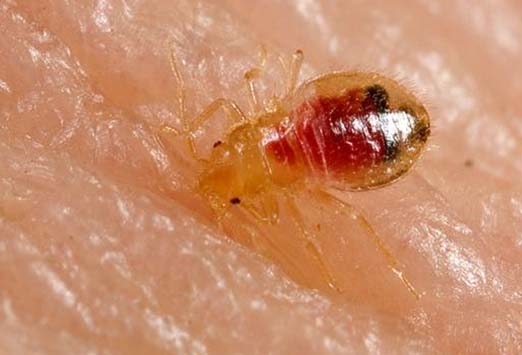
After bedbugs find a food source, they bite down with their mouths and inject anticoagulant and anesthetic compounds into the skin. Depending on the species, they feed on the host blood via one of two mechanisms. Vessel feeders directly insert their mouthparts into superficial capillaries, while pool feeders damage the superficial tissue and feed on the accumulated blood. As bedbugs feed, their color may change as they swell with the host blood.
Bed bugs have piercing/sucking mouthparts typical of the insect order Hemiptera. Bedbug bites themselves are typically painless. However, the subsequent allergic reaction that may develop can cause intense pruritus. It can be difficult to distinguish bedbug bites from other insect bites. In general, the sites of bedbug bites usually are:
* Red, often with a darker red spot in the middle
* Itchy
* Arranged in a rough line or in a cluster
* Located on the face, neck, arms and hands
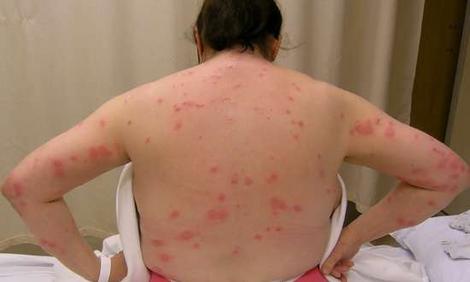 Some people have no reaction at all to bedbug bites, while others experience an allergic reaction that can include severe itching, blisters or hives. While feeding, bedbugs may inject one of several pharmacologically active substances, including hyaluronidase, proteases, and kinins. These compounds may induce different skin reactions, such as erythema, wheals, vesicles, or hemorrhagic nodules. Repeated bites may sensitize individuals, leading to more pronounced cutaneous manifestations or systemic hypersensitivity reactions. The local trauma from bedbug bites can lead to secondary bacterial infection, causing ecthyma, cellulitis, or lymphangitis. There is some evidence that bedbugs may also be a vector for hepatitis B and Chagas disease. Histologic findings from bite-site biopsy specimens typically show eosinophilic infiltrates, which are indicative of the allergic nature of the reaction.
Some people have no reaction at all to bedbug bites, while others experience an allergic reaction that can include severe itching, blisters or hives. While feeding, bedbugs may inject one of several pharmacologically active substances, including hyaluronidase, proteases, and kinins. These compounds may induce different skin reactions, such as erythema, wheals, vesicles, or hemorrhagic nodules. Repeated bites may sensitize individuals, leading to more pronounced cutaneous manifestations or systemic hypersensitivity reactions. The local trauma from bedbug bites can lead to secondary bacterial infection, causing ecthyma, cellulitis, or lymphangitis. There is some evidence that bedbugs may also be a vector for hepatitis B and Chagas disease. Histologic findings from bite-site biopsy specimens typically show eosinophilic infiltrates, which are indicative of the allergic nature of the reaction.
The resurgence of bedbugs in developed countries may be linked to increased international travel, legal and illegal immigration, changes in pest control practices, and insecticide resistance. Bedbugs are more common in crowded lodgings that experience high turnover in occupancy, such as apartment complexes, dormitories, homeless shelters, hotels of all types and costs, military barracks and refugee camps. If you're going to Shaolin, expect them, regardless of where you stay. That goes for anywhere in China for that matter; and as the Chinese become more mobile and travel around other countries in Asia, bedbugs have become more common in hotels of those countries.
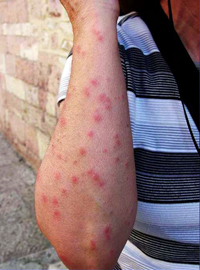 Bedbugs don't usually stay on their human hosts after their meal, but they might take refuge in clothes or luggage left nearby on the floor. If you're traveling and bedbugs get into your luggage, you might bring them home with you. All they need is a warm host and plenty of hiding places. Even pristine homes and hotels can harbor bedbugs. And while bedbugs may hitchhike on your belongings, they also can crawl about as fast as a ladybug. So they can easily travel between floors and rooms in hotels or apartment complexes.
Bedbugs don't usually stay on their human hosts after their meal, but they might take refuge in clothes or luggage left nearby on the floor. If you're traveling and bedbugs get into your luggage, you might bring them home with you. All they need is a warm host and plenty of hiding places. Even pristine homes and hotels can harbor bedbugs. And while bedbugs may hitchhike on your belongings, they also can crawl about as fast as a ladybug. So they can easily travel between floors and rooms in hotels or apartment complexes.
Some varieties of bedbugs prefer to feed on birds or bats, so they may take up residence in your attics or eaves. If their preferred prey migrates south, these bedbugs will settle for feeding on the humans in the house.
A female bedbug can lay more than 200 eggs in her lifetime, which typically lasts for about 10 months. Newly hatched bedbugs are nearly colorless, so they are hard to spot. They shed their skin five times as they grow, and need a blood meal for each molt.
Treatment for bites is typically supportive. Local antiseptic lotions or antibiotic creams can be applied for secondary infections, whereas corticosteroid creams and oral antihistamines can be used for allergic reactions. Bedbugs can be eliminated through the use of permethrin insecticides, baited traps, special bedbug-free beds, and bed nets. Homemade methods, such as wrapping duct tape around bed legs as shown, may be effective, but bedbugs have been known to climb other objects and then fall down onto a bed.
Disease Transmission: The possibility of transmission of human disease agents by bed bugs is controversial. Since the insects repeatedly suck blood from humans and live a relatively long time, conceivably they might ingest a pathogen and later transmit it. It has been reported that bed bugs have been suspected in the transmission of 41 human diseases; however, finding a blood-sucking insect infected with a pathogen does not mean that it is a competent vector of that agent, or even a vector at all.
There have been studies of possible HIV transmission by bed bugs. Webb and colleagues found that HIV could be detected in bed bugs up to 8 days after exposure to highly concentrated virus in blood meals, but no viral replication was observed, nor was any virus detected in bed bug feces. In addition, by using an artificial system of feeding bed bugs through membranes, the authors could not demonstrate mechanical transmission of HIV.
Perhaps the best candidate for transmission by bed bugs is hepatitis B virus (HBV). Pools (groups) of bed bugs collected from huts in northern Transvaal, South Africaan area with high rates of human HBV sero positivitytested positive for hepatitis B surface antigen (HBsAG). In addition, HBsAG has been shown to persist in bed bugs for at least 7.5 weeks after experimental feeding. However, that same study found no biologic multiplication of HBV in bed bugs. Another study suggested that bed bug feces might be considered a source of mechanical transmission of HBV infection under some circumstances. However, finding surface antigen in feces is no indication of viable virus.
Whether HBV infectivity survives the bed bug digestive process is unknown. A transmission experiment with chimpanzees helped resolve this issue, although the sample size was small (3 animals). In that study, bed bugs were fed HBV-infected blood through a membrane. Ten to 13 days later, sub-samples of the bugs were tested for infectivity; 53% to 83% were found to be infected. Then, approximately 200 of the infected bugs took meals from the 3 chimpanzees. No infections or seroconversions resulted. To confirm infectivity of the inoculum, the researchers then injected the same 3 animals with a portion of the original blood used to infect the bed bugs. HBV infections followed quickly in all 3 chimpanzees.
Whether or not bed bugs transmit human disease agents remains a point of contention. Attorneys representing plaintiffs bitten by the bugs in hotel rooms often firmly state that the risk is real and warrants compensation. However, until further evidence proves otherwise, I think the best summary of current data goes something like this: "Even though bed bugs have been found naturally infected with many disease agents, they have never been proved to transmit even one."
Pediculosis
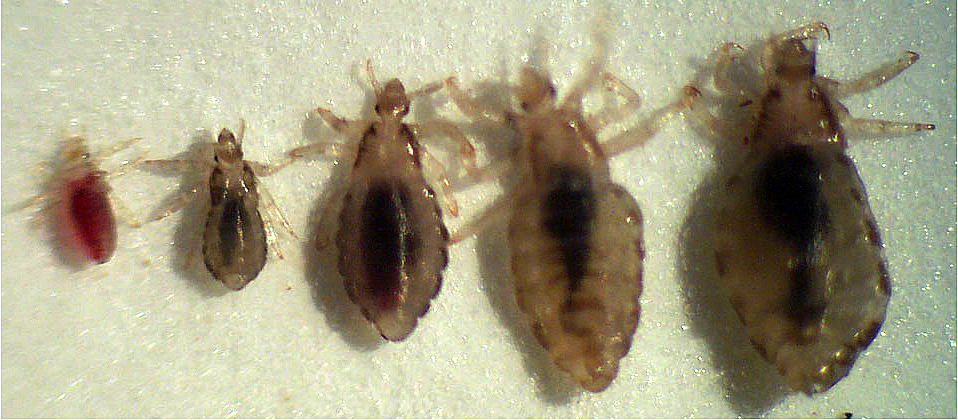
Lice are parasitic insects from the order Phthiraptera. Louse eggs are called "nits." Although lice are classified as either chewing or sucking, only the sucking lice purposefully affect humans. The 3 types of human lice are Pediculus humanus capitis (head louse), Pediculus humanus corporis (body lice), and Pthirus pubic (pubic louse, or "crabs"). All 3 types periodically feed on human hosts by piercing the skin and ingesting blood. "Pediculosis" refers to an infestation of lice and is a major problem in the United States.
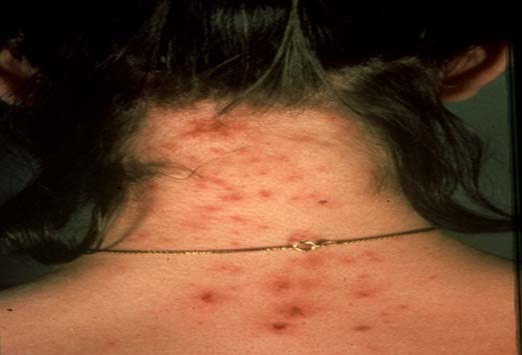
Body lice infest clothing, laying their eggs on fibers in fabric seams. They typically affect homeless persons, who do not wash or change their clothes often. Body lice are a known vector of 3 major bacterial diseases: Rickettisa prowazekii, Bartonella quintana, and Borrelia recurrentis. Rickettsia prowazekii causes typhus and may produce epidemics during periods of overcrowded conditions and body louse infestations. Bartonella quintana causes trench fever, which was a major problem during World War I. Borrelia recurrentis causes relapsing fever, which is highly fatal among malnourished individuals.
Head and pubic lice both infest hair; they can be distinguished by their different body plans, notably the clawlike limbs on the pubic louse. Both organisms though lay their eggs on the base of hair fibers. Head lice are common in urban areas and spread easily because infected individuals are reluctant to share information with contacts owing to the social stigma associated with infestation. Pubic lice are generally spread through sexual contact and may be used as a marker of other sexually transmitted diseases. DNA extracted from pubic lice in victims of rape have been used to help identify perpetrators. Lice found on the eyelashes are typically pubic lice rather than head lice.
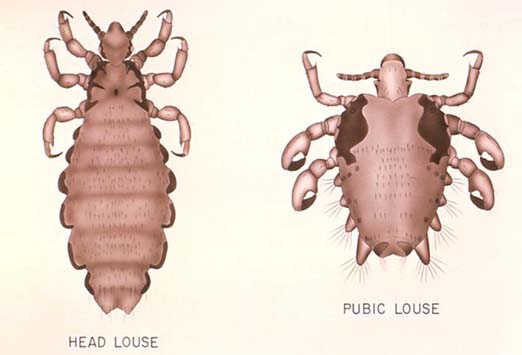
The most common symptom of infestation is pruritus, but children may be asymptomatic. On examination, patients with head lice may have occipital lymphadenopathy and impetigo. The scalp will show excoriations and dark specks of louse dung, nits, and adult lice. The most common site of infestation is the retroauricular scalp. Body lice are found on the seams of clothing; hemosiderin-stained purpuric spots on the skin are a cutaneous sign of infestation. Pubic lice are typically visible throughout the pubic hair. Pediculosis is diagnosed by direct visualization and identification of adult lice or nits. Louse bites may reveal intradermal hemorrhage and eosinophilic infiltrates on histologic examination.
 Treatment of lice infestation is typically approached as a community-wide problem; otherwise, reinfestation will reoccur. Fomite control by limiting the sharing of or contact between personal objects, such as combs, brushes, and clothing, is important. Pediculicides, such as permethrin or malathion, can be used to kill adult lice, but young nits do not have nervous systems and so are immune to neurotoxic agents. Specialty combs can help remove nits from hair follicles, as shown. For body lice, removal of infested clothing and laundering in hot water, ironing with a hot iron, or drying in a hot dryer are effective. Topical agents to be applied to clothing are also available.
Treatment of lice infestation is typically approached as a community-wide problem; otherwise, reinfestation will reoccur. Fomite control by limiting the sharing of or contact between personal objects, such as combs, brushes, and clothing, is important. Pediculicides, such as permethrin or malathion, can be used to kill adult lice, but young nits do not have nervous systems and so are immune to neurotoxic agents. Specialty combs can help remove nits from hair follicles, as shown. For body lice, removal of infested clothing and laundering in hot water, ironing with a hot iron, or drying in a hot dryer are effective. Topical agents to be applied to clothing are also available.
Mites
 “Mite” is a term commonly used to refer to a group of insect-like organisms, some of which bite or cause irritation to humans. While some mites parasitize animals, including man, others are scavengers, some feed on plants, and many prey on insects and other arthropods. In fact, there are nearly as many different types of mites as there are insects. Like their relatives, the ticks, mites pass through four stages of development: egg to larva to nymph to adult. All stages have eight legs except the six-legged larva.
“Mite” is a term commonly used to refer to a group of insect-like organisms, some of which bite or cause irritation to humans. While some mites parasitize animals, including man, others are scavengers, some feed on plants, and many prey on insects and other arthropods. In fact, there are nearly as many different types of mites as there are insects. Like their relatives, the ticks, mites pass through four stages of development: egg to larva to nymph to adult. All stages have eight legs except the six-legged larva.
Most mites never come in contact with humans, but some that do can affect a person’s health. Yet, in many situations where mites or other “invisible” arthropods are believed to be biting or “attacking” people, no causative organism is present. The irritation may be real or imagined: real, due to mechanical, chemical or other inanimate irritants, or imagined due to a psychological disorder.
Mites are invertebrates of the class Arachnida that can cause parasitic infections in humans. Mites are related to spiders and have 8 legs, as shown, unlike bedbugs and lice, which are insects and have six legs. Mites are an incredibly diverse group, with more than 48,000 species, but only a few have clinical implications for humans. Sarcoptes scabiei, shown, is a parasitic mite that causes scabies in humans. Scabies is a worldwide health problem that flourishes in areas of overcrowding, delayed diagnosis and treatment, and poor public education. Transmission is via direct and prolonged contact with an infected individual, but infected fomites in bedding or clothing can survive for 3 days.
The life cycle of a mite lasts 30 days and is spent in the human epidermis. Mite eggs are hatched in the superficial skin layers, where they mature into adult mites. They secrete proteases that allow them to degrade the stratum corneum and feed on the dissolved tissue. Fecal matter left behind the migrating mite produces the stereotypical burrows. Most patients are infected with 10-100 mites, but those who are immunocompromised may harbor more than a million, in a condition termed "crusted scabies" (formerly "Norwegian scabies"). The primary clinical symptoms is intense pruritus secondary to a hypersensitivity reaction. The most severe complication is bacterial superinfection.
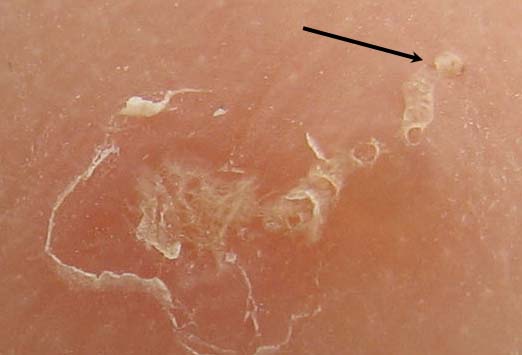
While mites rarely transmit disease to humans in the United States, they definitely impact health in ways that range from simply being a nuisance when they enter homes in large numbers, to inflicting severe skin irritation that can cause intense itching. The most commonly encountered mites, including those that can adversely affect human health, are listed below.
Clover Mites: This mite sometimes enters homes and other buildings by the thousands, causing panic among residents. Though they do not bite or cause health-related problems, clover mites can be a nuisance. If smashed when they crawl over carpets and drapery, the mites leave a red stain. Clover mites can be red, green or brown, and have front legs that are about twice as long as their other legs. They feed on clover, ivy, grasses, fruit trees and other plants. Well-fertilized lawns are favored. Clover mites enter homes when their food plants are removed or dry up. They are most active in fall, and will seek refuge in structures as colder weather approaches, when molting (shedding skin) and when laying eggs. Typical of many mite species, all clover mites are females capable of laying viable eggs without fertilization. They have no need for male mites!
House Dust Mites: Much information (and misinformation) has appeared in recent years about house dust mites. Virtually invisible to the naked eye, house dust mites are nevertheless real. It has been shown that, like cockroaches, dust mites and their feces can become airborne and are one of the most common indoor allergens. That is, most persons diagnosed as being allergic to “house dust” are actually allergic to the dust mites whose bodies and feces are major components of dust. Roaches and dust mites have also been implicated in triggering asthma attacks. But, unlike rodent mites, itch mites and chiggers, skin irritation is rarely caused by exposure to dust mites. Although they may “hitchhike” on clothing, dust mites do not live on people. They feed primarily on dander, flakes of dead skin that fall from people and animals. Upholstered furniture, pillows and mattresses typically harbor more dust mites than carpeting.
Itch Mites: These mites prey upon insects. Species including the straw itch mite (P. tritici) infest stored products. Humans are bitten when they contact straw, hay, grasses, leaves, seeds or similar materials harboring the mites. Another species (P. herfsi) also attacks insects living in sheltered locations, including the larvae of midges (gnat-like flies) in leaf galls, and the eggs of cicadas beneath tree bark. When separated from their insect prey, itch mites may contact and bite other animals including humans.
The mites cannot be seen and the bites are not felt, but leave itchy red marks that can resemble a skin rash. When itch mite populations ‘explode,’ people and other animals may receive numerous bites. Fortunately, the mites cannot live on humans, do not survive indoors, and are not known to transmit disease.
Rodent and Bird Mites: Rodent and bird mites may bite people when their hosts die or abandon their nests. Three types of rodent mites readily bite humans: the house mouse mite (Liponyssoides saguineus), spiny rat mite (Laelaps echidnina) and tropical rat mite (Ornithonyssus bacoti). The house mouse mite prefers to suck the blood of mice, but also will bite rats and people, often causing a rash around the bite. They prefer warm places (e.g., around pipes and furnaces) where rodents live. The spiny rat mite feeds on rats at night and hides by day in cracks and crevices around rat nests and resting places. The tropical rat mite’s bite is painful and causes skin irritation and itching.
Mites that normally infest birds also bite people. The northern fowl mite (Ornithonyssus sylviarum) and chicken mite (Dermanyssus gallinae) primarily infest chickens, but also pigeons, starlings and sparrows. The northern fowl mite cannot survive for more than a month off its host, while the chicken mite hides in cracks and crevices near bird nests during the day and feeds by night. Cheyletiella mites infest both birds and mammals. They may prey on other mites and insects living on the host’s skin. They can cause a mange-like condition in pets, and itching in people who handle infested pets. They do not stay long on humans.
Chiggers: Two species of chigger mites attack humans and other mammals, birds and reptiles. The nymph and adult stages prey on insects. It is the six-legged larval stage that typically feeds on rodents or ground dwelling birds but will bite people when they are available. Chigger larvae are red to yellow in color and appear as scarcely visible specks. When they detect the carbon dioxide exhaled by an animal, they climb on soil or vegetation and wave their front legs to contact it, then grasp it with their mouthparts. They do not suck blood but cut into the skin, inject skin-digesting saliva and suck up the liquefied skin. If not dislodged, the chigger will feed for several days. The bite becomes inflamed, hardens and itches. Chiggers spend most of their lives in cracks in the soil. They are typically found in rural, less disturbed areas, but can persist for years on soil in new subdivisions.
Scabies Mites: Sarcoptes scabiei are mites that infest mammals, including man. Most human infestations result from person-to-person contact. Although they can transfer from animals to humans and vice versa, several types of scabies mites exist, each having a preferred host species on which it reproduces. In dogs, scabies mites cause mange. Scabies is the most common and important condition resulting from mite infestation of humans. Unlike other mites, scabies mites actually burrow up to 3cm into the skin to lay eggs. The mites are believed to feed on skin and secretions. The entire life cycle (10-17 days for human-infesting scabies mites) is spent on their host. Without a host, they survive only a few days. In previously unexposed individuals, a scabies infestation may go unnoticed for more than a month. Then, severe irritation and itching develops, especially at night.
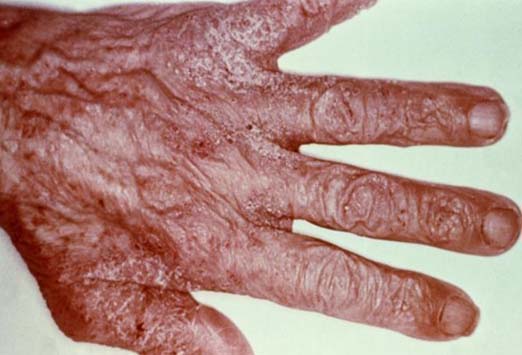 In adults, scabies infection usually occurs on the flexor wrists, interdigital web spaces of the hands (shown), dorsal feet, axillae, elbows, waist, buttocks, and genitalia. Pruritic papules and vesicles on the scrotum and penis in men or areolae in women are characteristic. Infants and children may have diffuse lesions on the face, scalp, neck, palms, and soles. Primary scabies is typically evident as small papules, vesicles, and burrows, whereas secondary lesions are due to rubbing and scratching. Diagnosis can be made with light microscopic identification of mites, larvae, ova, or fecal pellets.
In adults, scabies infection usually occurs on the flexor wrists, interdigital web spaces of the hands (shown), dorsal feet, axillae, elbows, waist, buttocks, and genitalia. Pruritic papules and vesicles on the scrotum and penis in men or areolae in women are characteristic. Infants and children may have diffuse lesions on the face, scalp, neck, palms, and soles. Primary scabies is typically evident as small papules, vesicles, and burrows, whereas secondary lesions are due to rubbing and scratching. Diagnosis can be made with light microscopic identification of mites, larvae, ova, or fecal pellets.
Histologic examination of a skin biopsy specimen may reveal mites (arrows) within a hyperkeratotic stratum corneum, but a dermal infiltrate composed of lymphocytes, histiocytes, mast cells, and eosinophils is characteristic. Treatment of scabies consists of a scabicidal agent (eg, permethrin cream or oral ivermectin), antipruritic agents, and antimicrobials if the patient is secondarily infected. All household members and close personal contacts should be treated. Clothes, linens, and towels need to be laundered with hot water. Patients should typically be reevaluated 2-4 weeks after treatment to ensure adherence and mite eradication.
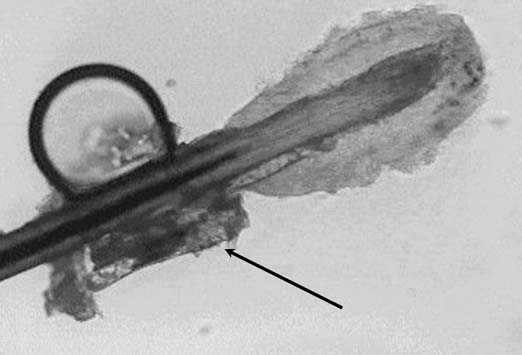 Demodicosis is an infection of the eyelid caused by the mite Demodex folliculorum. The mites infest the eyelash hair follicles, where they feed off of sebaceous gland cells. Accumulation of mite waste material may cause follicular plugging, leading to dry eyes and chalazion formation. D folliculorum has also been implicated in pityriasis folliculorum, with rosacealike papules, and diffuse erythema. On examination, patients may have thickened or scaled lids, loss of lashes, conjunctival inflammation, or decreased vision. Treatment involves a combination of brushing, diluted baby shampoo washings, and antibiotic ointment applications. Prognosis is typically very good.
Demodicosis is an infection of the eyelid caused by the mite Demodex folliculorum. The mites infest the eyelash hair follicles, where they feed off of sebaceous gland cells. Accumulation of mite waste material may cause follicular plugging, leading to dry eyes and chalazion formation. D folliculorum has also been implicated in pityriasis folliculorum, with rosacealike papules, and diffuse erythema. On examination, patients may have thickened or scaled lids, loss of lashes, conjunctival inflammation, or decreased vision. Treatment involves a combination of brushing, diluted baby shampoo washings, and antibiotic ointment applications. Prognosis is typically very good.
Control and Eradication: When mites have been identified, appropriate control measures can be employed. A vacuum sweeper can be a valuable weapon in the mite control arsenal. Infestations of clover mites, rodent and bird mites in and around structures can sometimes be eliminated by vacuuming alone. Vacuuming may be less effective, but still of value, in controlling various food mites, straw itch mites and dust mites. Note that dust mites are not prevalent in ductwork; therefore, duct cleaning is not recommended for dust mite control. However, a high-efficiency particulate air (HEPA) filter can be installed to help prevent airborne allergens, including dust mite particles.
Moisture control also can be important. Mites transfer air and water through their body walls and are subject to desiccation at low humidity. Dust mite populations, for example, suffer when a relative humidity of 50 percent or less is maintained. On the other hand, high humidity can cause mite populations to increase exponentially.
Well-ventilated homes in dry climates contain few dust mites. Homes with a relative humidity that consistently rises above 50 percent can contain more than 100 dust mites per gram of dust. To reduce dust mite numbers, a relative humidity of less than 50 percent must be maintained for several weeks. Any fluctuation in humidity, however brief, seems sufficient for dust mites to remain and reproduce. Daily activities such as air-conditioning and showering, will cause humidity levels to fluctuate in portions of the home. Thus, other means of controlling dust mites should be employed in addition to humidity control.
For dust mites, products containing benzyl benzoate, and possibly abrasive dust formulations, may provide some control when applied to flooring and floor coverings. Bedding, draperies, floor coverings and furniture should be cleaned regularly. Pillows, mattresses and upholstered furniture can be discarded or sealed in plastic covers to help prevent dust mite infestation, and to reduce ongoing infestations and their associated allergens. Persons suffering from allergic reactions or asthma should consult a physician.
Exclusion methods also can be used for certain mites, e.g., clover mites. Structural entry points, e.g., gaps in and around foundations, doors, windows, vents, utility lines, etc., should be sealed. This will help to keep clover mites outdoors along with rats, mice, birds -- and the mites these pests bring when they are allowed to nest in structures. If nests are found, they should be removed and the area around them vacuumed. Other non-chemical methods include maintaining a plant-free border around foundations and reducing the amount of fertilizer applied to lawns – both of which help to keep clover mites away from structures.
Pesticides labeled for use against mites, known as miticides or acaricides, can be effective against clover mites and chiggers in grassy areas. For chiggers, however, insect repellents containing 7 percent to 30 percent “DEET” should be used as the first line of defense. To dislodge any chiggers that may have attached, take a hot, soapy bath or shower immediately after visiting natural areas where chiggers are present.
Images courtesy of the US Centers for Disease Control and Prevention, Wikimedia Commons, and other university websites.
